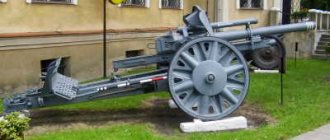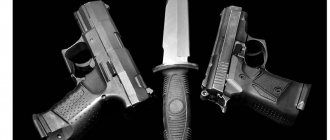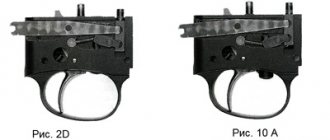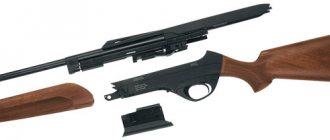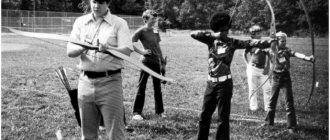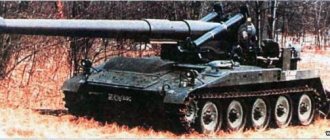The D-30 is a Soviet 122mm howitzer developed in the early 60s. It was one of the most popular artillery systems in the Soviet army and was actively exported. Currently, the D-30 is in service with several dozen armies around the world. In 1978, the D-30 howitzer was modernized.
In addition to the USSR, the 122-mm D-30 howitzer was produced in Egypt, Iraq, China and Yugoslavia. In Russia, production of this weapon ceased in 1994.
The D-30 has participated (and is participating) in dozens of military conflicts, demonstrating high reliability and efficiency. Without exaggeration, this howitzer can be called the most famous Soviet artillery weapon. The D-30 has excellent shooting accuracy, as well as excellent loading speed and maneuverability. Today, about 3,600 units of this artillery piece are in service in different countries of the world (excluding the CIS).
Several self-propelled guns, both domestic and foreign, were created on the basis of the D-30. The most famous of them is the 2S1 Gvozdika self-propelled artillery mount.
It is the D-30 howitzer that is used in St. Petersburg for the daily noon shot.
History of creation
In the 50s, however, Soviet artillery flourished. Anti-aircraft guns, medium-caliber guns, and anti-tank guns were developed and improved. But divisional artillery, intended to support divisions, continued to use the M-30 122mm howitzer, developed before the Great Patriotic War. Although it was considered a certain “limit of perfection,” it had serious shortcomings that were revealed in battles.
The M-30 guidance flywheels were located on different sides of the barrel, making it impossible to target the target using just one crew number. If there was a need to shoot directly, this was prevented by the unsatisfactory design of the sight and the lack of scales in the sighting reticle for determining the range and lateral corrections. And the large mass of the howitzer did not allow it to be quickly deployed if the enemy attacked from an unexpected direction.
The participation of the M-30 in the Korean War again reminded us of the gun's disadvantages, and in 1954, the development of a new howitzer for the divisional level finally began.
It was taken up by the Design Bureau of Plant No. 9, located in Sverdlovsk. The design team was headed by Fedor Petrov. Throughout 1955, the design of the gun was carried out. By December, the first prototype was built.
The fine-tuning of the gun dragged on for several years - the customer demanded that any possible shortcomings be eliminated before mass production began; new ammunition for the howitzer also had to be “tested” from scratch. In 1960, the howitzer was put into service under the factory designation D-30 and the clarifying index GRAU “2A18”.
Links[edit]
- Francesco Palmas (2012). "Il contenzioso del sahara occidentale fra passato e presente" (PDF). Informazioni della Difesa
(in Italian). No. 4. pp. 50–59. Archived (PDF) from the original on 06/2018/12. Retrieved June 12, 2022. - Cooper, Tom; Fontanellaz, Adrian (October 2016). "La guerre du Kagera." Batailles et Blindés
(in French). No. 75. Caraktère. pp. 72–81. ISSN 1765-0828. - Collateral, Stephen; Luczak, Wojciech; Beldam, Barry (1992). Armor of the War in Afghanistan
. Armor 2009. Concord Publications. paragraph 7. ISBN 978-9623619097. - Cooper, Tom (2013). Great Lakes Fire: The Second Congo War, 1998-2003. UK: Helion & Company Limited. p. 49. ISBN 978-1-920143-84-8.
- “[Syria] Highway M-20 - Deir ez-Zor. Hunting for “snakes” - Highway M-20 - Deir ez-Zor. Hunting for "snakes". YouTube
. Archived from the original on December 30, 2022. Retrieved January 13, 2018. - PressTV News Video (August 26, 2017). "Debate - Daesh's dying days". Archived from the original on May 26, 2022. Retrieved January 13, 2018 - via YouTube.
- “05/10/14 Fighting for Donetsk airport. Exclusive interview with Givi". Archived from the original on October 11, 2014. Retrieved July 1, 2019.
- شبكة المجد (September 8, 2014). "# السلسلة_الوثائقية_الحوثيون - الجزء الأول" . Archived from the original on June 14, 2016. Retrieved January 13, 2022 - via YouTube.
- "YouTube". www.youtube.com
. Archived from the original on August 17, 2022. Retrieved January 13, 2018. - ^ abc Foss, Christopher (1977). Jane's Pocket Guide to Towed Artillery
. New York: Collier. paragraph 93. ISBN 0020806000. OCLC 911907988. - Binnie, Jeremy (4 July 2017). "Algeria displays locally developed self-propelled artillery". IHS Jane 360
. Archived from the original on July 6, 2022. Retrieved July 6, 2022. - https://bastion-karpenko.narod.ru/Univer_KZ.pdf Archived January 22, 2015 at the Wayback Machine (in Russian)
- “Wheeled self-propelled howitzer SH2 122 mm. Technical characteristics Technical characteristics Photo description | China artillery vehicles and weapons systems UK | China Chinese army military equipment armored UK". armyrecognition.com. 2011-11-28. Archived from the original on December 9, 2016. Retrieved February 27, 2022.
- ARG. "Semser 122 mm self-propelled howitzer - Military-Today.com". www.mmilitary-today.com
. Archived from the original on January 14, 2022. Retrieved January 13, 2018. - Hoang Le (2013-11-27). “Xem quân đội Cuba tập trận Bastion 2013 | Quân đội" . Kienthuc.net.vn. Archived from the original on November 22, 2016. Retrieved February 27, 2022.
- "Khalifa GHY02 D-30 122mm wheeled self-propelled howitzer 6x6 technical specifications specifications | Sudan Sudanese Army UK Artillery Systems | Sudan Sudanese army military equipment Great Britain". armyrecognition.com. 2013-03-15. Archived from the original on March 11, 2022. Retrieved February 27, 2022.
- "Laos unveils 122mm wheeled howitzer D-30 installed in the Urals". armyrecognition.com
. 2018-12-27. Archived from the original on January 03, 2022. Retrieved January 2, 2022. - "New wheeled artillery systems for the Egyptian army based on the Russian Ural-4320 6x6 truck". armyrecognition.com
. 2016-05-08. Archived from the original on 2016-05-10. - ^ abcdefghijklmnopqrstu vwxyz aa ab ac ad ae af ag ah ai aj ak al am an ao ap aq ar "Artillery Systems of the Future: 2016 Market Review" (PDF). Tidworth: Defense IQ. 2016. Archived from the original (PDF) on January 22, 2018. . Retrieved January 21, 2022.
- Military Balance 2016, p. 181.
- ^ ab Military Balance 2016, p. 492.
- "Assessment of PLA Artillery Modernization". Center for the Study of Ground Warfare
. - Military Balance 2016, p. 83.
- Military Balance 2016, p. 393.
- Military Balance 2016, p. 324.
- Military Balance 2016, p. 445.
- ^ abcde "Trade registers". armstrade.sipri.org
. Archived from the original on August 5, 2009. Retrieved January 13, 2018. - Finnish Defense Forces. "Republic of Finland's 2022 AEMI (Annual Exchange of Military Information) Report". Retrieved August 10, 2018.
- Military Balance 2016, p. 93.
- Military Balance 2016, p. 450.
- Equipment of the Iraqi army 1930-2017. 2
. paragraph 119. - Military and defense. "Peshmerga military equipment". Business Insider. Archived from the original on August 6, 2022. Retrieved February 27, 2017.CS1 maint: multiple names: authors list (link)
- Military Balance 2016, p. 491.
- Military Balance 2016, p. 334.
- Gibson, Neil; Fedyushko, Dmitry (January 22, 2019). "Laotian military parades of Russian and Chinese-made equipment". Jane 360
. London, Moscow. Archived from the original on January 23, 2022. Retrieved January 24, 2022. - Military Balance 2016, p. 340.
- Military Balance 2016, p. 342.
- Military Balance 2016, p. 120.
- "Myanmar". Archived from the original on November 29, 2014. Retrieved November 29, 2014.
- "SIPRI Trade Register". Stockholm International Peace Research Institute.
- Military Balance 2016, p. 280.
- Military Balance 2016, pp. 190-201.
- "Morocco" (PDF). Tel Aviv: Institute for National Security Studies. March 1, 2016. Archived from the original (PDF) on June 26, 2022. Retrieved June 25 +2016.
- "Sudan - Global Trade, Local Influence: Arms Transfers to All Sides in Sudan's Civil War" (PDF). Human Rights Watch report
.
10
(4): August 24, 1998 - Military Balance 2016, p. 471.
- Military Balance 2016, p. 137.
- Military Balance 2016, page 203.
- "Zimbabwe Defense Force". defenseweb.co.za. October 13, 2014. Archived from the original on November 15, 2022. Retrieved June 28, 2015.CS1 maint: bot: original URL status unknown (link)
- Krott, Rob (October 2003). "Armament of Macedonia: New nation rearms and fights". Small Arms Review
. Vol. 7 no. 1. Archived March 30, 2022. Retrieved March 30, 2022.
Device
To ensure the possibility of all-round firing, the designers of the D-30 used a previously unused scheme with a carriage consisting of three frames. Moving apart, they “lie” on the ground and are fixed in it with driving coulters. The upper machine and the swinging part of the implement can rotate freely.
The howitzer barrel is equipped with a slotted muzzle brake, and the vertical wedge bolt is semi-automatic.
The sighting devices of the howitzer are a D-726 mechanical sight, combined with a PG-1M gun panorama (fourfold magnification) and an OP-4M optical sight. The latter is used for direct fire, it provides a 5.5x magnification and an aiming reticle that includes a rangefinder scale, range and lateral correction scales.
The mechanical sight serves as an auxiliary sight when firing direct fire, and is the main one when firing from closed positions. The elevation and aiming angles, which are entered into the sight, are measured using the PG-1M panorama.
The D-30 howitzer was transported by AT-L and AT-P tractors, as well as ZIL-157 trucks. Later, MT-LB tractors and Ural-375 or 4320 trucks were used. The suspension of the chassis is torsion bar, it is impossible to fire “from the wheels” - they must be hung.
On the D-30A modification, the slotted muzzle brake was replaced with a two-chamber one, and the wheels filled with sponge rubber were replaced with pneumatic ones. This made it possible to increase the towing speed.
Modifications of the D-30 gun
D-30. Basic modification, adopted in 1963
D-30A. Howitzer variant after modernization in 1978. The gun was equipped with a new two-chamber muzzle brake, brake lights and side lights were installed on the dashboard
DA18M-1. Modification with rammer
D-30J. Modification developed in Yugoslavia
Saddam. Version of the gun created in Iraq
Type-96. Chinese modification of howitzer
Khalifa. Sudanese modification
Semser. A modification developed in Israel for the army of Kazakhstan. It is a self-propelled gun based on KAMAZ-63502 with a D-30 gun
Khalifa-1. Modification developed in Sudan: self-propelled guns on a KAMAZ-43118 chassis with a D-30 gun
Ammunition
In terms of ballistic characteristics, the new gun was supposed to occupy an intermediate position between the M-30 howitzer and the A-19 cannon. This led to the need to create ammunition for the D-30s from scratch. And the only suitable projectile from the existing ones was the high-explosive fragmentation OF-462.
This projectile, developed in 1931, weighed 21.7 kg and was loaded with 3.67 kg of TNT. During the development of the D-30, new long-range projectiles were developed for the old M-30 gun - chemical, smoke and lighting. They could also be adapted for firing from the new howitzer.
By the 1980s, the range of D-30 fragmentation ammunition was replenished with howitzer shells of the OF42 and OF56 families.
In the last of them, the mass of the explosive charge was increased to four kilograms, replacing TNT with hexal. The fragmentation effect is ensured by setting the fuses to instantaneous action, when the projectile does not have time to penetrate deeper into the obstacle, and the body is almost not deformed. The area of continuous destruction by fragments was estimated as 18 m along the front and 8 m in depth.
When firing at tanks, fragments weighing about 1 g could not cause significant damage to them, but they could easily damage surveillance devices and antennas. When the fuses are set to high-explosive action, the projectile is somewhat buried in the obstacle. OF56, exploding in the ground, creates a crater three meters in diameter and more than a meter deep. When fired at a tank, a shell can destroy its attachments and break through the armor of the sides or roof.
To ensure the ability of artillery to fight tanks, cumulative shells were developed for the D-30. The first attempt to create such a projectile for 122mm howitzers was the rotating BP1, which penetrated up to 180mm of armor. Later it was replaced by projectiles, which were stabilized in a rifled barrel by a special rotating shutter, and in flight by the tail.
A BK3 projectile made according to this design could penetrate armor up to 400mm thick.
The later BK13 projectile already resembled a smoothbore gun projectile in appearance, and its armor penetration became even higher - up to 460mm.
To defeat large masses of infantry in 1973, the Sh1 projectile equipped with arrow-shaped striking elements was adopted. And the most advanced and high-tech howitzer 122mm D-30 projectile was the high-explosive fragmentation "Kitolov", corrected by a laser beam. The propellant charge in a plastic or steel case is supplied in three versions - a full charge, a reduced variable charge and a special charge for firing BP1 cumulative projectiles.
Improvements to the 122 mm howitzer model 1910/30 during modernization.
The main direction of modernization was to increase the range of the 122-mm howitzer by introducing ammunition with a long-range projectile. It was possible to shoot from a howitzer model 1910 only on the fourth charge, which consisted solely of the main package of gunpowder. The long-range shells were 0.64 caliber longer than the old ones. Moreover, this difference was mainly in the belt part, which was practically absent in old-style shells.
An attempt to fire a full projectile led to a rupture of the barrel, since in the presence of all the beams there was no internal volume necessary for the expansion of the powder gases, and the temperature and pressure increased sharply. Therefore, they shot by removing all the bundles except the main package. To correct the situation, it was necessary to lengthen the charging chamber. Which is what they did, boring it into one caliber.
Firing new shells was accompanied by an increase in recoil, as a result of which it was necessary to strengthen the recoil devices, the lifting mechanism and the carriage itself. The carriage of the 122-mm howitzer model 1910/30 was strengthened at the serial production stage. Probably this shortcoming was revealed by exploitation among the troops. Firing a long-range grenade led to an increase in dynamic loads compared to the previous artillery shot. Even firing with the old projectile and the newly introduced propellant charge No. 1 significantly exceeded the dynamic characteristics permissible for a non-modernized howitzer.
The strengthening of the carriage naturally affected the weight of the howitzer model 1910/30; its weight increased to 1466 kg, while the non-modernized 122-mm howitzer weighed 1331 kg. The placement of a bored barrel on an old carriage, as well as the use of old sleds and recoil devices, were prohibited.
To exclude this possibility, modernized carriages, recoil guards and barrels began to be marked without fail with the inscriptions “strengthened”, “model 1910/30”, “extended chamber”.
An increase in the firing range of the 122-mm howitzer model 1910/30 forced changes to the sighting devices. For arr. Model 1910/30 adopted a “normalized” sight. This sight was used for a wide variety of artillery systems and differed only in the mounting and the cutting of distance scales to suit the ballistics of a particular weapon.
The mobility and fire maneuverability of the 122-mm howitzer model 1910/30 remained at the same level, since the single-beam carriage itself, as well as the wheel travel, did not undergo significant design changes. The mechanism for horizontal aiming of the howitzer remained the same. The speed of the carriage, as before, did not exceed six kilometers due to the absence of any suspension and the presence of wooden wheels with a metal rim.
During 1930, modernization was completely completed. The 122-mm howitzer model 1910/30 passed tests, was put into production by the Motovilikha plant and entered service with the troops.
Performance characteristics
The howitzer had no direct analogues in terms of performance characteristics abroad. Foreign systems, as a rule, had either a smaller caliber or a larger one.
At the same time, unlicensed production of the D-30 was established in China (based on a study of samples purchased in Egypt), which indicates the demand for such a system.
| Weight, kg | 3200 |
| Length, mm | 7800 |
| Barrel length, mm | 4785 |
| Initial projectile speed, m/s | 690 (for high-explosive fragmentation shells) |
| Maximum firing range, m | 15300 (for high-explosive fragmentation shells) |
| Rate of fire, rounds per minute | 7-8 |
| Calculation, man | 6 |
Western armies considered the disadvantage of the D-30 to be that the high pressure created by the muzzle brake was twice the established norms. Therefore, it was recommended that crews fire from a distance using a cord. But the difficulties that arise when fixing the D-30 carriage on frozen ground, concrete or rocks were also negatively assessed by the Soviet troops.
Operators[edit]
Map of D-30 operators in blue with former operators in red
D-30 of the Armenian Army
Current operators[edit]
- Afghanistan: 85 as of 2016 [19][Update]
- Albania: 250
- Algeria: 160 [19]
- Angola: 500 [19]
- Armenia: 69 as of 2016 [19][Update]
- Artsakh [20]
- Azerbaijan: 129 as of 2016 [19][Update]
- Bangladesh: [19]
- Belarus: 48 as of 2016 [19][Update]
- Boko Haram [21]
- Bosnia and Herzegovina: 100 [19]
- Burundi: 18 [19]
- Cambodia [19]
- China: 500 Type 96
[19] [22] - Republic of the Congo: 10 [19]
- Democratic Republic of the Congo [19]
- Croatia: 54 as of 2016 [23][Update]
- Cuba: [24] 100 on the T-34, 55 on the T-55 chassis and 25 on the KrAZ-255 6x6. [ citation needed
] - Egypt: 190 D-30M [19] [25]
- Djibouti: 6 [19]
- Ethiopia: [26] 309 delivered 1998–2000 [27]
- Eritrea [19]
- Estonia: 42 H63, delivered 2009 [27]
- Finland: 234 to 471 H63 [28] [29]
- Ghana: 6 [19]
- Georgia: 58 as of 2016 [19][Update]
- Guinea-Bissau: less than 18 [30]
- India: 520 as of 2016 [19][Update]
- Iran: 540 [19]
- Iraq [31] Kurdistan [32] [33]
Former operators[edit]
- Czechoslovakia
- Islamic State [21]
- Macedonia - 108 in 2003 [49]
- Moldova - 18 from Romania, delivered in 1992 [27]
- Poland - Not working.
- Soviet Union - Transferred to successor states.
- Yugoslavia - passed to successor states.
Exploitation
In the Soviet Army, the D-30 howitzer became the main weapon of regimental and divisional artillery. Two howitzer batteries were each part of an artillery division of tank and motorized rifle regiments. In divisions, an artillery regiment was armed with 122mm howitzers.
In the airborne regiments, the D-30 was found as an exception. The Army of the Russian Federation initially maintained the same structure until the transition to a brigade organization. And in 2013, they announced the removal of D-30 howitzers from service, which were planned to be replaced by 152mm artillery systems at the division level and 120mm universal guns in regiments.
For the first time, however, the weapon entered into battle as part of the armies of Arab countries during the wars with Israel. Due to poor training and low morale of the soldiers, the howitzer did not show itself in any way, and the Israelis captured many D-30s as trophies. And Soviet troops were able to test the howitzer in battle in Afghanistan. And there, having large elevation angles and the ability to conduct all-round fire, it turned out to be indispensable in organizing defense. After the collapse of the USSR, the D-30 had to fight in all the conflicts that unfolded in the post-Soviet space - from the Chechen wars to the conflict with Georgia and events in Ukraine.
Government forces in Syria still use the D-30, as well as improvised self-propelled guns based on, for example, trucks, armed with this weapon.
Iraqi and Afghan howitzers were largely abandoned by armies during the American invasion, and were then either used to arm newly created government forces or given to terrorist groups. A similar situation is observed in Libya.
D-30s are in service with some African countries, but since their number sometimes does not reach even a dozen, there is no need to talk about their combat value.
The D-30 howitzer appeared more than half a century ago. But so far it is not an obsolete tool that has lost its value, which only the poorest countries can afford. On the contrary, in terms of its qualities it still meets all the requirements and in the right hands can be a formidable force.
And if you supplement the panorama and optical sight with a ballistic computer, its capabilities can reach a whole new level. The design of the howitzer turned out to be successful in terms of ease of use - any crew can easily master its handling. If the D-30 was not the best Soviet howitzer, it was definitely one of the best.
Use of the D-30 howitzer
The D-30 is one of the most successful examples of Soviet artillery weapons. Its main advantages are simplicity, reliability, good accuracy of fire, sufficient firing range, high speed of movement and mobility.
The howitzer is perfect for highly mobile units. For the Soviet landing, a technique was developed for dropping the D-30 by parachute; preparing the gun for landing takes only a few minutes. The D-30 can be transported on the external sling of a Mi-8 helicopter.
The howitzer has been used in dozens of different conflicts in many parts of the world. It was actively used by Soviet troops in Afghanistan, federal forces used the D-30 during the first and second Chechen campaigns, today the howitzer is used in the Syrian conflict, Ukrainian troops use it in an anti-terrorist operation in the east of the country.
Bolt mechanism and barrel
What kind of shutter was equipped with the D-30? The howitzer, the photo of which you can see above, has a standard semi-automatic bolt (wedge). The barrel is rifled, with a total of 36 grooves. To raise or lower it, flywheels of the lifting and turning mechanisms are used.
To protect the crew from bullets and shrapnel, a special shield device is mounted on the gun. In addition, the shield serves as a barrier to the powerful muzzle wave that appears at the moment the shot is fired and can also cause severe injuries to the crew that services the gun. In 1978, the howitzer was modernized, during which the design of the shield device and the carriage itself was somewhat simplified and improved.
At the same time, the plan to convert the gun to 152 mm caliber was rejected. The D-30 howitzer has retained its main technical characteristics.
How does it work?
According to experts, it will take the crew no more than three minutes to bring the howitzer into combat position. One frame is left in a stationary position, the rest are moved apart by 120 degrees. Thanks to this design of the gun carriage, it became possible to fire in a circular manner without moving it.
The D-30 is equipped with a semi-automatic wedge shutter. Within one minute, up to eight shots can be fired from this artillery unit. Thanks to a special barrel arrangement (the muzzle brake and knurler are located in the upper part), the line of fire is reduced and amounts to 900 m. According to experts, due to the reduced dimensions, the D-30 is less noticeable. Thanks to its short line of fire, the howitzer is ideal for anti-tank defense.
